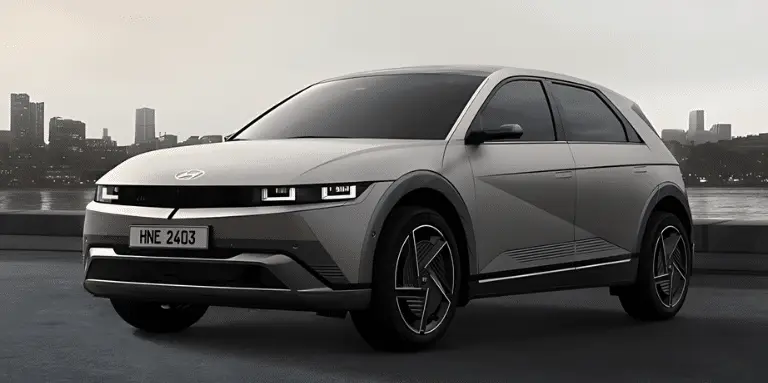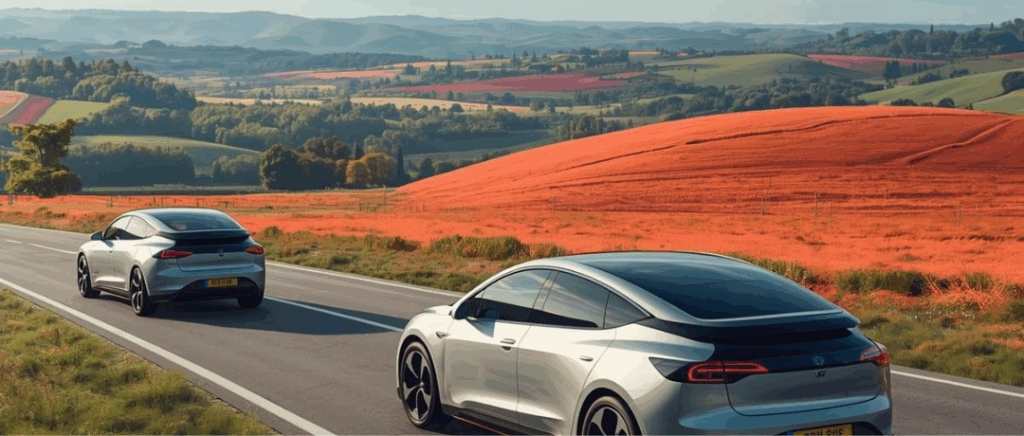A quantum leap with the 77.4 kWh battery
La Hyundai Ioniq 5 has taken a major step forward with the introduction of its new 77.4 kWh batteryThis represents a significant improvement on the initial capacity of 72.6 kWh. This enhancement increases the vehicle's range by around 25 km, meeting the growing expectations of drivers in terms of distance covered on a single charge.
Hyundai has also announced a future version with an 84 kWh batteryThis could increase the range by a further 20 to 30 km, making the Ioniq 5 even more attractive on the electric vehicle market. Despite this increase in capacity, the brand has managed to maintain its impressive recharging performance, enabling it to go from 10 to 80 % charge in just 18 minutes on fast charging stationswith a DC charging capacity of up to 225 kW.
These battery enhancements position the Ioniq 5 as a leading choice for consumers, reducing range anxiety and meeting the needs of more practical and efficient everyday driving.
Wheels and range: understanding the impact of wheel size
The size of the rims on the new Hyundai Ioniq 5 has a significant impact on the vehicle's range. Two wheel options are available: 19-inch and 20-inch. The 19-inch wheels provide a range of 460 km according to the WLTP cycle, while the 20-inch wheels reduce this to 430 km.
This difference can be explained by the fact that the larger rims increase rolling resistance and resistance to wear. aerodynamicsThis means higher energy consumption. Choosing the right rim size therefore involves a compromise between style and energy efficiency. Smaller rims offer greater range, while larger rims are often preferred for their aesthetic appeal.
Hyundai strategy: make the Ioniq 5 more competitive against the Tesla Model Y and the Peugeot e-3008
This development is designed to strengthen the Ioniq 5's competitive position against rivals such as the Tesla Model Y and the Peugeot e-3008This reduces the anxiety associated with autonomy for potential buyers.
However, these improvements usually come with a price increase, which could affect the model's competitiveness, particularly in Europe where its base price is already high. Beyond the increase in battery capacity, Hyundai has also made other improvements to the Ioniq 5, including cosmetic changes, the addition of a new N-Line trim, and potential updates to infotainment and driving aids.
These developments demonstrate Hyundai's commitment to keeping the Ioniq 5 at the cutting edge of technology and attractiveness in the Electric SUVswhile adapting to the growing demands of the market in terms of autonomy and performance.
Design revisited: cameras instead of mirrors
The Hyundai Ioniq 5 has introduced an innovation with the use of digital cameras in place of traditional door mirrors, particularly in the Namsan Edition version. These Digital Side Mirrors (DSM) replace conventional door mirrors with exterior-mounted cameras, which project their image onto OLED screens inside the vehicle.
This design change is aimed at reducing air resistance, thereby improving the vehicle's fuel efficiency. In addition to the aerodynamic benefits, these cameras offer improved visibility, even in bad weather, by providing an enhanced, unobstructed rear view. This technology, already available on Korean models, is being offered for the first time in Europe on a vehicle from the Hyundai group, accentuating the technological and modern appeal of the Ioniq 5.
Our Hyundai Ioniq 5 test drive
Strategic price cut for the Hyundai Ioniq 5: drive further for less
The Hyundai Ioniq 5 has recently undergone a strategic price cut, making this electric vehicle more accessible to a wider range of consumers. The price cut is designed to make the Ioniq 5 more competitive in the electric vehicle market by offering an attractive combination of advanced technology and affordability. For example, in France, the starting price for a new Ioniq 5 is now €39,700including equipment such as GPS, reversing camera and other comfort and safety features.
This pricing strategy enables Hyundai to attract more potential buyers by offering them the opportunity to benefit from a range of up to 570 km on a single chargeWith its 800 V battery and ultra-fast recharging capability.
By lowering the cost of entry for this model, Hyundai hopes not only to increase its market share, but also to encourage wider adoption of electric vehicles, by offering a sustainable and technologically advanced mobility solution at a more accessible price.
Kia EV6: a rival for the Hyundai Ioniq 5
A notable competitor to the new Hyundai Ioniq 5 is the Kia EV6. Developed by the same Korean automotive group, the Kia EV6 shares the E-GMP platform with the Ioniq 5, giving it similar technical characteristics, including battery options of up to 77.4 kWh. In terms of performance, the Kia EV6 also offers a comparable range of up to 528 km according to the WLTP cycle, and power of up to 325 bhp for four-wheel drive versions.
The design of the Kia EV6 is also distinctive, with a sporty, dynamic aesthetic that appeals to a young, modern clientele. What's more, the Kia EV6 stands out for its fast-charging capabilities, enabling it to go from 10 to 80 % charge in around 18 minutes at fast-charging stations, making it very practical for long journeys.
With prices in a similar range to the Ioniq 5, the Kia EV6 represents a solid alternative for consumers looking for an electric SUV that combines performance, range and advanced technology.
For further information: Kia EV6 vs Hyundai Ioniq 5, which one to choose?
Conclusion
The new Hyundai Ioniq 5 is positioned as an attractive choice in the electric vehicle market, combining increased range thanks to its new 84 kWh battery, fast charging performance, and aesthetic improvements with the addition of an N-Line finish. Despite a slight reduction in price, the model remains relatively expensive, particularly when compared with rivals such as the Tesla Model Y.
However, its impressive technical features, such as its ability to recharge from 10 to 80% in just 18 minutes, make it a competitive electric vehicle.
If you're thinking of buying an electric car or theinstallation of a recharging pointBut it's important to note that electric mobility experts like Beev can help you with your project, helping you to navigate the different options available and make the choice that best suits your needs.
With Beev
Switch to
Electric cars
or install your
Charging station
For individuals and businesses
































